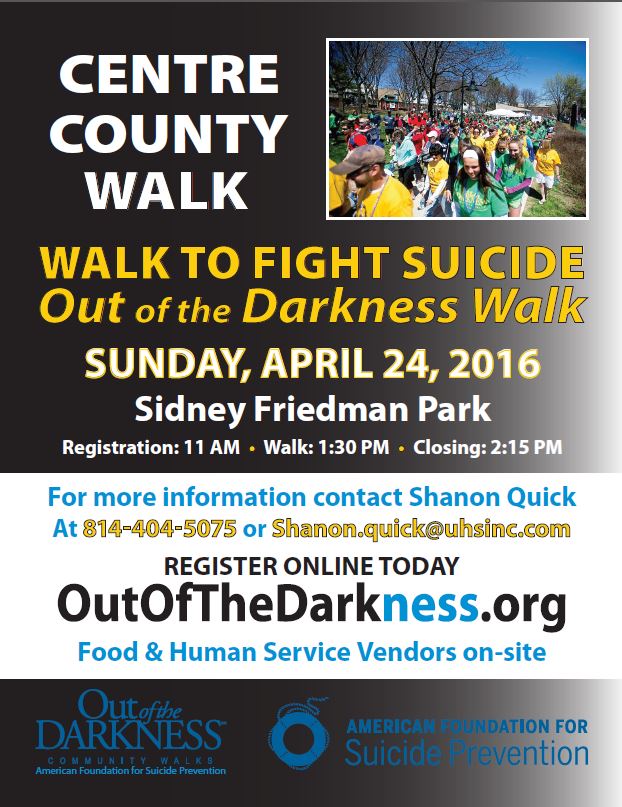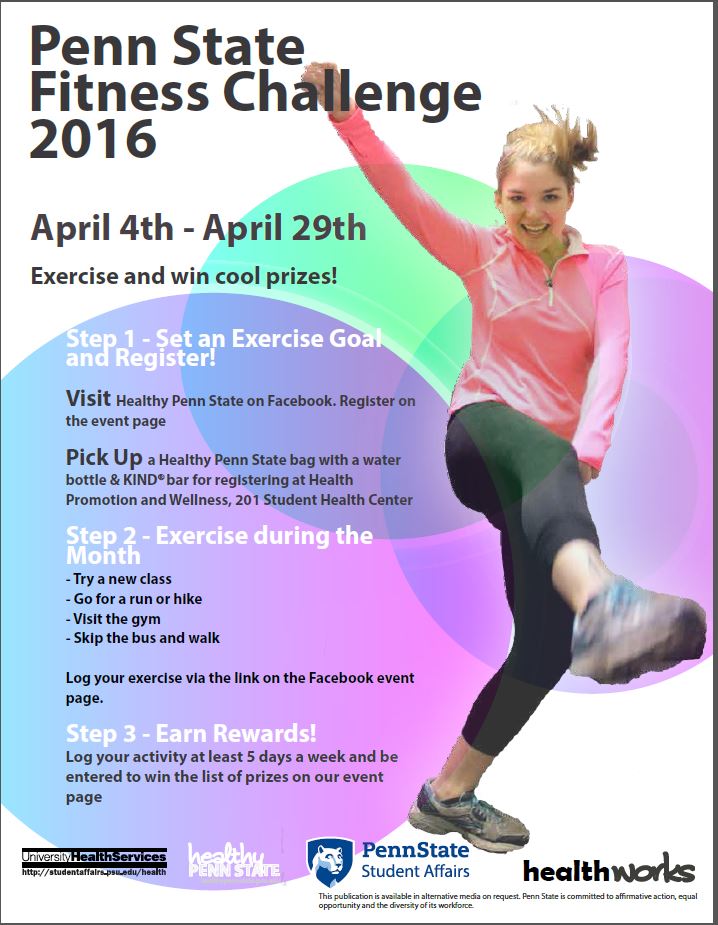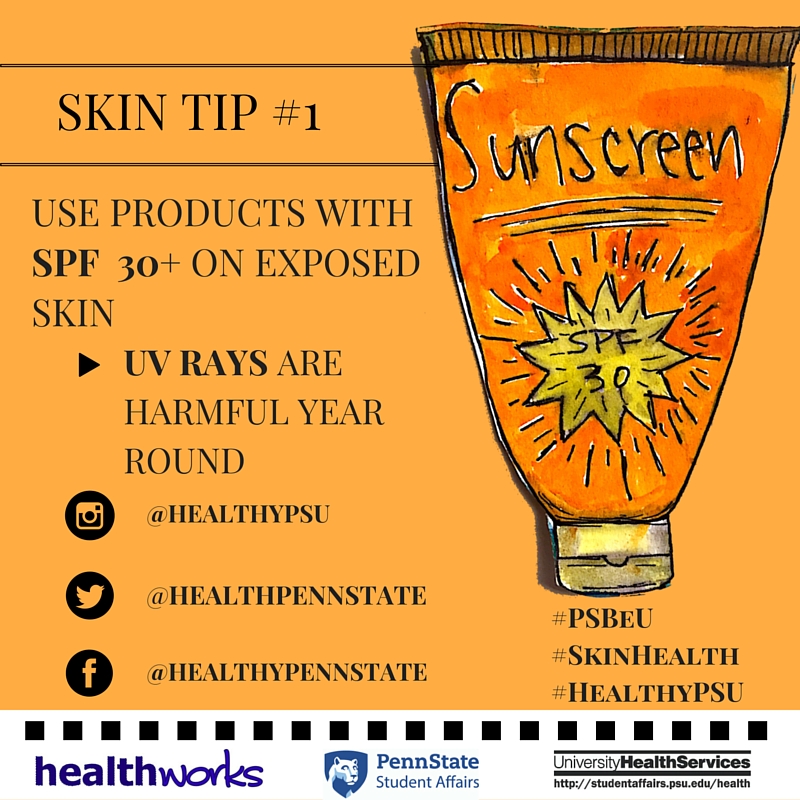The Out of the Darkness walk raises awareness about suicide prevention and provides support for suicide survivors and those who are struggling with suicidal experiences. The event also raises funds for the American Foundation for Suicide Prevention. The walk will begin at the Sidney Friedman Park (off of Fraser St near the State High football field) this Sunday, April 24th. Students and community members are invited to participate in this 5K non-competitive walk. There will be a prewalk ceremony and educational materials will be available. You can register at the event beginning at 11am or online until Friday the 22nd. 
All posts by Leanne M Lenz
Sun Screen Tips
Happy Valley is wakening from its winter hibernation. Blue-White weekend typically marks the start of warm weather in State College. Whether you are heading to the game on Saturday or running the Beaver Stadium Run on Sunday, here are a few tips to help you handle a full day in the sun.
- Use SPF 30+ on exposed skin; UV rays are harmful year round.
- Choose a “broad spectrum” sunscreen. This means that it protects against both UVA and UVB
- Use waterproof sunscreen. It will stay on longer, even if you perspire or get wet.
- Overexposure to UV radiation can suppress your immune system. This will impede your skin’s ability to properly protect itself and heal.
- Wear a hat or visor to protect your eyes.
- Seek shade. The Blue-White Game is the only game when you can choose your seat in the stadium. Choose the shady side; you’ll be glad you did!
Shocking amounts of sugar have been found in hot flavored drinks.
Action on Sugar, a UK charity staffed by medical experts, analyzed the sugar levels of 131 hot drinks, 98% were rated as having excessive sugar or more than 13.5 grams of sugar per serving. Thirty-five percent contained more sugar than a can of Coke. So, what’s the problem?
It is widely known that too much sugar leads to increased risk of cavities, obesity and type 2 diabetes. Research has also found a possible link between the consumption of excess sugar and high cholesterol, high blood pressure, some cancers, and non-alcoholic liver disease. Even if you are slim and appear healthy, too much sugar can have a negative impact on your health which may only appear later in life. [1][2]
Naturally occurring sugars, found in whole fruits or vegetables, are not considered harmful to your health. Free sugars, sometimes referred to as “added sugars,” are those that have been added by the manufacturer, cook or consumer. This includes sugars in syrups and fruit juices. Foods containing free sugars often have very little or no nutritional benefit.
Don’t be misled by a food or drink product that has been labeled as a “good source of energy.” Many of these products contain added sugar. Carbohydrates generate energy for the body and can be found in fruits, vegetables, breads, pasta and rice. There is no nutritional value in added sugars.[3]
The World Health Organization recommends that adults consume no more than 10% of their daily calories from sugar (around 50 grams based on a 2,000 calorie diet). Ideally, the WHO recommends lowering sugar intake to 5% for added health benefits.[4]
If you’d like to lower your sugar intake, try making small adjustments to your diet and lifestyle. Try a cup of hot tea in place of your typical latte or pack a healthy snack for your afternoon pick-me-up. Drink water (using a reusable water bottle) instead of energy drinks, soda, or juices with added sugar.
Learn more about sugar at actiononsugar.org.
[1] http://www.mayoclinic.org/diseases-conditions/high-blood-cholesterol/in-depth/triglycerides/art-20048186
[2] http://my.clevelandclinic.org/services/heart/prevention/risk-factors/cholesterol/triglycerides
[3]http://www.actiononsugar.org/index.html
[4] Sugar Intake for Adults and Children; Guidelines, World Health Organization
Sexual Violence Awareness Week March 28 – April 1
Sexual violence awareness week brings attention to the issue of sexual violence and highlights resources available on campus. The week is full of activities and events that can empower survivors and teach students how small actions can have a large impact. Learn more and support the cause by attending one or more of the following events.
Walk a Mile in Her Shoes: Noon, March 28, Alumni Hall in the HUB-Robeson Center
Eve Ensler: 6:30 p.m. March 28, Alumni Hall
Vulnerable Art and Trauma Survivorship: 2:30 p.m. March 29, Palmer Lipcon Auditorium, Palmer Museum of Art
“Tough Guise 2” film screening: 8 p.m. March 29, Freeman Auditorium in the HUB-Robeson Center
Stand for State workshop: 2:30 p.m. March 30, Room 233B HUB-Robeson Center
Sisters on the Runway Fashion Show: 6:30 p.m. March 30, Heritage Hall in the HUB-Robeson Center
“Pursuit of Truth” film screening: 8:00p.m. March 31, Waring Commons
Gala benefiting the Centre County Women’s Resource Center: 6-8 p.m. April 1, Hintz Family Alumni Center (tickets are $15 and will be available at the door)
Skin Tip #1
Adderall related ER visits on the rise.
Most of you know that using prescription drugs without a prescription is illegal and dangerous. Unfortunately, research shows some college students have the perception that “study drugs” are harmless and can make you smarter (DeSantis and Hane, 2010). This false belief may be responsible for a 67% increase in nonmedical use of Adderall from 2006 to 2011.
Researchers from the Bloomberg School of Public Health at Johns Hopkins recently looked at data from three national surveys to identify trends. According to the Drug Abuse Warning Network, the number of emergency room visits involving Adderall misuse increased from 862 visits in 2006 to 1,489 in 2011. Common problems associated with nonmedical Adderall use include anxiety, agitation, and insomnia, but the stimulant drug can also lead to increased blood pressure and in rare events, heart attack and stroke.
Source: Chen, et. al, Prescriptions, Nonmedical Use, and Emergency Department Visits Involving Prescription Stimulants. J Clin Psychiatry. 2016
Eating Disorder Awareness
Eating Disorder Awareness
If someone is showing signs of an eating disorder, early intervention can significantly decrease the likelihood that a more serious, life threatening eating disorder will develop. Early intervention can prevent years of struggle and can lead to greater chances for full recovery. [1]
Here are some of the signs that a person may be struggling with an eating disorder:
- Chronic dieting despite being underweight
- Constant weight fluctuations
- Obsession with calories and fat contents of food
- Engaging in ritualistic eating patterns, such as cutting food into tiny pieces, eating alone, and/or hiding food
- Continued fixation with food, recipes, or cooking; the individual may cook intricate meals for others but refrain from eating
- Depression or lethargy
- Avoiding social functions, family and friends. May become isolated and withdrawn
- Switching between periods of overeating and fasting[2]
The National Eating Disorders Association offers a free and confidential online screening for eating disorders. The screening only takes a few minutes. At the end, you will be given information and next steps.
Campus Resources:
- Counseling and Psychological Services (CAPS), 863-0395
- University Health Services (UHS)
- Clinical Services, 863-0774
- Nutrition Clinic, 863-0461
- Healthy Eating and Living Support
Internet Resources:
[1] http://www.nationaleatingdisorders.org
[2] http://www.eatingdisorderhope.com
Alcohol Poisoning is a Medical Emergency
Have you ever been concerned about a friend who has had too much to drink, but you are not quite sure what to do? Alcohol poisoning occurs when a large amount of alcohol is consumed, usually over a short period of time. This leads to a rapid rise in BAC caused by having more alcohol in the body than the liver can handle. Knowing the signs can help you save someone’s life.
The signs for alcohol poisoning:
• Mental confusion, stupor
• Passed out or difficult to wake
• Cold, clammy, pale, or bluish skin
• Slowed breathing (fewer than 8 breaths/minute)
• Vomiting while asleep or awake
Tips to help someone:
1. CALL 911! Never assume a person will “sleep it off.” Even after someone is passed out, their blood alcohol level can continue to rise.
2. Turn a vomiting person on his/her side to prevent choking.
3. Keep the person awake, if possible.
4. Never leave the person unattended.
Under Penn State’s Responsible Action Protocol, students who seek medical assistance, by notifying the appropriate authorities (i. e., calling 911, calling the police, getting an RA), for a peer suffering from alcohol poisoning or related problems will not face University disciplinary action for their own alcohol violations, unless they are responsible for other violations.
Pennsylvania law also provides immunity for an underage person who seeks help for a friend who has alcohol poisoning.
Alcohol poisoning is a medical emergency. Call 911! You could save someone’s life. Learn more from Penn State’s Party Smart Guide.
Four Ways to Get Moving this Week
By Emily DuBartell, BBH May ’18
Whether you’re looking to get into shape or searching for ways to mix up your workout routine, we’ve compiled fun, inexpensive ways to stay in shape – most of which don’t even involve leaving campus.
1. Free yoga at UHS
Yoga is an ancient form of exercises that increases flexibility, sharpens mental acuity, decreases stress and improves your overall fitness. Adding yoga to your exercise routine also provides an excellent form of active recovery that will help with flexibility and prevent injuries. One of the main reasons people avoid yoga is the expense that often comes with taking a yoga class. Luckily, University Health Services offers free yoga classes from 4:00 -5:00 pm on Tuesdays, Wednesdays and Thursdays in 205 Student Health Center. You don’t even need to bring a mat! UHS provides mats and props. This is a popular service so be sure to get there early!
2. Run on campus
If you want an activity that fits your schedule, running is a great option. Make a playlist to jam out to, grab your sneakers and maybe a buddy and go! Not sure where to start? Check out the Campus Run/Walk Map. Remember that you can always add to or shorten the lengths of the sample runs based on your fitness level. On the yellow loop, for example, if you want to shorten the run, turn onto Curtin Road from University Drive rather than running to Park Ave.
3. Go for a swim
Swimming is an excellent form of cardio and a great way to cross-train if it’s not a part of your regular exercise regimen. There is a great pool in White Building available to anyone with a Penn State Fitness membership. The McCoy Natatorium also offers a beautiful facility that is open to the public. You can enter using your Penn State Fitness membership as well, or by paying a $3 admission fee. If you want to swim regularly, you also have the option of buying a swim pass. Click here for more pricing information.
4. Hike Mount Nittany
If you’re looking to mix up your exercise schedule, hiking is a perfect choice. With the warmer temperatures around the corner, hiking Mount Nittany is an excellent way to get outside. You can choose to take either the Blue Trail (4.6 miles round trip) or the White Trail (3.5 miles round trip). Though the hike up to the top is difficult, the view is definitely worth it. Ideally, go on a clear day and you’ll get an excellent view of the stadium and campus! If you don’t have a ride, don’t worry. There is a CATA Bus stop in Lemont near the trail head! For more information about Mount Nittany, click here.

